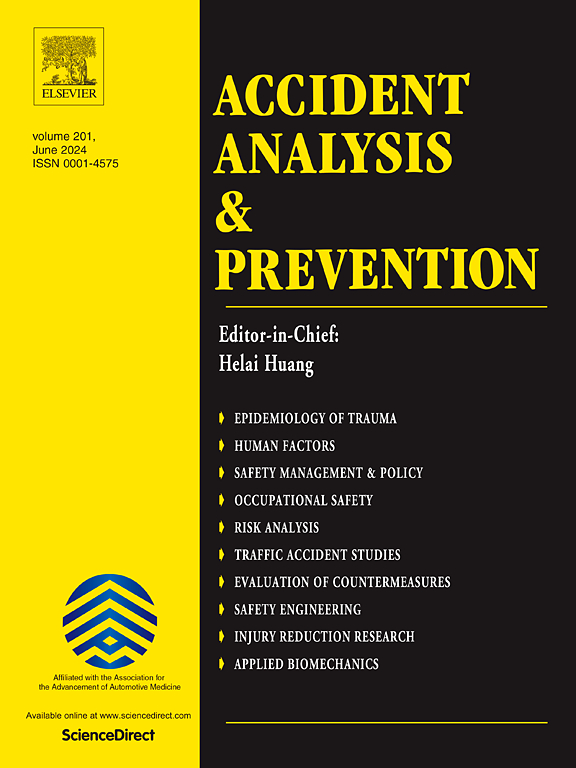Differences in injury severities between elderly and non-elderly taxi driver at-fault crashes: Temporal instability and out-of-sample prediction
IF 5.7
1区 工程技术
Q1 ERGONOMICS
引用次数: 0
Abstract
The population of elderly individuals (over 64 years) in Seoul, South Korea, grew from 1.4 million to 1.7 million between 2018 and 2023. During the same period, the number of elderly taxi drivers rose from 27,739 to 35,166. Additionally, the number of fatal and severe injury (FSI) crashes caused by at-fault elderly taxi drivers has steadily increased, surpassing those caused by non-elderly taxi drivers since the onset of the COVID-19 pandemic. This shift has raised safety concerns among transportation authorities and the public. Previous studies have explored the factors influencing taxi driver crash injury severity outcomes; however, there has been little focus on investigating the stability of these factors over time and across taxi driver age groups. This study examines the stability of factors influencing taxi driver at-fault crash injury severity outcomes and the differences between elderly and non-elderly taxi driver at-fault crash severities using data from Seoul, South Korea (2017–2023). Risk factor stability across taxi driver at-fault age groups and time periods was assessed using log-likelihood ratio tests, which revealed that these factors were not stable, highlighting the need for estimating separate models. Separate statistical models were developed using the random parameters binary logit framework to examine the associations between risk factors and FSI outcomes. This approach allowed us to account for potential heterogeneity in the means of the random parameters for both elderly and non-elderly taxi driver at-fault crashes across different periods: pre-, during, and post-COVID-19. Factors such as midnight to early morning hours, dry roads, signal violations, elderly not-at-fault parties, and posted speed limits of 80 km/h increased the likelihood of FSI outcomes in most models. The results showed that the indicator for elderly not-at-fault drivers increased the probability of FSI outcomes the most when involved in a crash with elderly at-fault taxi drivers. Additionally, the probability of FSI outcomes was highest for elderly at-fault taxi drivers who violated traffic signals. Heterogeneity analysis revealed that intersection-related taxi driver at-fault crashes were likely to be more FSI on weekdays. Out-of-sample simulations demonstrated a clear difference in injury severities between elderly and non-elderly taxi drivers, with non-elderly taxi drivers predicting fewer FSI outcomes in recent years. Key measures to improve taxi safety for drivers over 64 include introducing free and mandatory assessments to ensure that taxi drivers are fit for the profession. Additionally, taxi management companies could implement fatigue and distracted driving detection systems to monitor driving behavior, especially during midnight and early morning hours. Collected data could be used to incentivize elderly taxi drivers to maintain safe driving practices. Further, introducing more flexible or reduced hours, part-time shifts, and retirement incentives for unfit taxi drivers would further reduce risks. Attracting younger drivers through incentives could also lessen reliance on elderly drivers, lowering the risk of FSI crashes. Finally, championing enhanced safety training, improved lighting and signal visibility at intersections—especially at night—stricter enforcement on high speed roads, and lower speed limits in high-risk areas would further increase safety.
老年和非老年出租车司机过失碰撞伤害严重程度的差异:时间不稳定性和样本外预测。
2018年至2023年间,韩国首尔的老年人口(64岁以上)从140万增加到170万。在同一时期,老年出租车司机从27739人增加到35166人。此外,自新冠肺炎疫情发生以来,因老年出租车司机的过失造成的严重伤亡事故(FSI)持续增加,超过了非老年出租车司机造成的事故。这种转变引起了交通部门和公众的安全担忧。以往的研究探讨了影响出租车司机碰撞伤害严重程度结果的因素;然而,很少有人关注这些因素随时间和出租车司机年龄组的稳定性。本研究利用韩国首尔(2017-2023)的数据,检验了出租车司机过失碰撞伤害严重程度结果影响因素的稳定性,以及老年和非老年出租车司机过失碰撞严重程度的差异。使用对数似然比测试评估了出租车司机过错年龄组和时间段的风险因素稳定性,结果显示这些因素不稳定,突出了估计单独模型的必要性。使用随机参数二元logit框架建立了单独的统计模型,以检查危险因素与FSI结果之间的关联。这种方法使我们能够解释不同时期(covid -19之前、期间和之后)老年和非老年出租车司机过失事故的随机参数均值的潜在异质性。在大多数模型中,午夜至凌晨、干燥的道路、违反信号、无过错老人聚会、限速80公里/小时等因素增加了FSI结果的可能性。结果表明,当与老年无过错出租车司机发生碰撞时,老年无过错司机的指标增加了FSI结果的可能性最大。此外,违反交通信号的老年出租车司机发生FSI结果的可能性最高。异质性分析显示,在工作日,与十字路口相关的出租车司机过失撞车事故更可能是FSI。样本外模拟表明,老年和非老年出租车司机在受伤严重程度上存在明显差异,近年来,非老年出租车司机预测的FSI结果更少。改善64岁以上司机驾驶的士安全的主要措施包括推行免费和强制性的评估,以确保的士司机适合该行业。此外,出租车管理公司可以实施疲劳驾驶和分心驾驶检测系统来监控驾驶行为,特别是在午夜和清晨时段。收集的数据可用于激励老年出租车司机保持安全驾驶习惯。此外,引入更灵活或减少工作时间、兼职轮班和对不适合的出租车司机的退休激励措施,将进一步降低风险。通过激励措施吸引年轻司机也可以减少对老年司机的依赖,降低交通事故的风险。最后,支持加强安全培训,改善十字路口的照明和信号可见度——特别是在夜间——在高速公路上更严格的执法,在高风险地区降低速度限制,将进一步提高安全性。
本文章由计算机程序翻译,如有差异,请以英文原文为准。
求助全文
约1分钟内获得全文
求助全文
来源期刊

Accident; analysis and prevention
Multiple-
CiteScore
11.90
自引率
16.90%
发文量
264
审稿时长
48 days
期刊介绍:
Accident Analysis & Prevention provides wide coverage of the general areas relating to accidental injury and damage, including the pre-injury and immediate post-injury phases. Published papers deal with medical, legal, economic, educational, behavioral, theoretical or empirical aspects of transportation accidents, as well as with accidents at other sites. Selected topics within the scope of the Journal may include: studies of human, environmental and vehicular factors influencing the occurrence, type and severity of accidents and injury; the design, implementation and evaluation of countermeasures; biomechanics of impact and human tolerance limits to injury; modelling and statistical analysis of accident data; policy, planning and decision-making in safety.
 求助内容:
求助内容: 应助结果提醒方式:
应助结果提醒方式:


